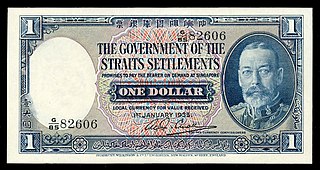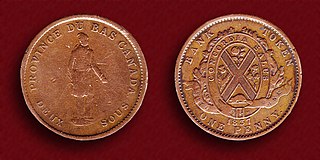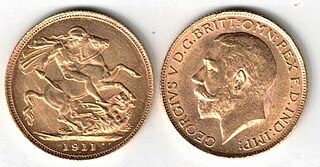Related Research Articles

The Canadian fifty-cent coin is a Canadian coin worth 50 cents. The coin's reverse depicts the coat of arms of Canada. At the opening ceremonies for the Ottawa branch of the Royal Mint, held on January 2, 1908, Governor General Earl Grey struck the Dominion of Canada's first domestically produced coin. It was a silver fifty-cent coin bearing the effigy of King Edward VII.

In Canada, a penny is an out-of-production coin worth one cent, or 1⁄100 of a dollar. According to the Royal Canadian Mint, the official term for the coin is the one-cent piece, but in practice the terms penny and cent predominate. Penny was likely readily adopted because the previous coinage in Canada was the British monetary system, where Canada used British pounds, shillings, and pence as coinage alongside U.S. decimal coins. Like all Canadian coins, the obverse depicts the reigning Canadian monarch at the time of issue.

The Straits dollar was the currency of the Straits Settlements from 1898 until 1939. At the same time, it was also used in the Federated Malay States, the Unfederated Malay States, Kingdom of Sarawak, Brunei, and British North Borneo.

The history of Canadian currencies began with Indigenous peoples in Canada prior to European contact, when they used items such as wampum and furs for trading purposes. The Indigenous peoples continued to use those items as currency when trade with Europeans began. During the period of French colonization, coins were introduced, as well as one of the first examples of paper currency by a western government. During the period of British colonization, additional coinage was introduced, as well as banknotes. The Canadian colonies gradually moved away from the British pound and adopted currencies linked to the United States dollar. With Confederation in 1867, the Canadian dollar was established. By the mid-20th century, the Bank of Canada was the sole issuer of paper currency, and banks ceased to issue banknotes.
The dollar was the currency of New Brunswick between 1860 and 1867. It replaced the pound at a rate of 4 dollars = 1 pound and was equal to the Canadian dollar. The New Brunswick dollar was replaced by the Canadian dollar at par when New Brunswick entered the Canadian Confederation.

The dollar was the currency of Nova Scotia between 1860 and 1871. It replaced the Nova Scotian pound at a rate of 5 dollars = 1 pound and was consequently worth less than the Canadian dollar. The Nova Scotian dollar was replaced by the Canadian dollar at a rate of 73 Canadian cents = 75 Nova Scotian cents, thus maintaining the difference between the two currencies established in 1860.

The pound was the currency of the Canadas until 1858. It was subdivided into 20 shillings (s), each of 12 pence (d). In Lower Canada, the sou was used, equivalent to a halfpenny. Although the £sd accounting system had its origins in sterling, the Canadian pound was never at par with sterling's pound.
The coins of Canada are produced by the Royal Canadian Mint and denominated in Canadian dollars ($) and the subunit of dollars, cents (¢). An effigy of the reigning monarch always appears on the obverse of all coins. There are standard images which appear on the reverse, but there are also commemorative and numismatic issues with different images on the reverse.
Since the 1976 Summer Olympics in Montreal, the Royal Canadian Mint has struck Summer and Winter Olympic coins to mark games held in Canada.

As Newfoundland did not join Canada until 1949, it had its own currency for many decades. It adopted its own decimal currency in 1863. Compared to other pre-Confederation British colonies, it had a wide selection of decimal coinage. The most important coin in Newfoundland was the Spanish American dollar, therefore, the Newfoundland government set its dollar equal in value to this coin. The new decimal cent was equal to the British halfpenny and $4.80 was equal to one pound sterling.
The Canadian silver dollar was first issued by the Royal Canadian Mint in 1935 to commemorate the Silver Jubilee of King George V. The coin's reverse design was sculpted by Emanuel Hahn and portrays a voyageur and a person of Indigenous descent paddling a birch-bark canoe. The faint lines in the background represent the Northern Lights. The voyageur design was used on the dollar until 1986. It was then replaced with the 1987 Canadian 1-dollar coin. 1967 marked the end of the silver dollar as a business strike, or a coin issued for circulation. After 1967, the dollar coin was made of nickel, except for non-circulating commemorative issues for the collector market, which continue to contain silver.

The Ottawa Mint sovereign is a British one pound coin minted between 1908 and 1919 at the Ottawa Mint (known today as the Ottawa branch of the Royal Canadian Mint. This has augmented debate among Canadian numismatists because some view these pieces as Canadian while others view them as British and thus distinct from the decimal series of Canadian coinage. Since the opening of the Ottawa Mint, the Dominion of Canada's government wanted to produce decimal gold coins. As it was a branch of the Royal Mint, it was obligated to mint sovereigns on request. When sovereigns were requested, it was usually for export causes. Gold used to produce sovereigns initially came from British Columbia or the Yukon.
From 2000 to 2019, there were various technological achievements in Canadian coin minting. The first RCM gold coin to be directly laser etched was the $100 Gold Leduc Oil Fields coin from 2002. The technique would later be used for the 2003 $100 Gold Marquis Wheat coin and the 2004 $20 Iceberg coin. In 2001, the RCM achieved innovation with the 2001 Marconi $5 silver coin. It was the first RCM coin to include a direct lasered finish. One of the technological breakthroughs for the RCM involved the 2006 Canadian Achievement series silver coin featuring Colonel Chris Hadfield. It was the first Canadian coin to be completely sculpted using computer software.
The Royal Canadian Mint has made coins with various themes. Most recently, ice hockey has been used for many numismatic releases. The first known ice hockey coin was for the 1988 Winter Olympics. Issued on February 25, 1986, the coin featured a goalie on the coin. Edge lettering was also used for the coin, the first time that it was used on silver coins.
Starting in 1997, the Royal Canadian Mint started to sell hockey medallions to the public. To commemorate the induction of Mario Lemieux in the Hockey Hall of Fame, a set was issued honouring all three inductees. One set was issued in Sterling Silver while another was issued in Nickel. The success of the release led to future issues.

The Prince Edward Island dollar was a unit of currency used in Prince Edward Island. The dollar replaced the Prince Edward Island pound in 1872 at a rate of 1 pound = 4.866 dollars. The dollar was subdivided into 100 cents.

The Newfoundland 2-dollar coin was issued in intermittent years between 1865 and 1888. It was the only circulation gold coin issued by a British colony. Although few coins were issued, it was broadly used in Newfoundland and eastern Canada. The coin became scarce in 1894 because of hoarding following the collapse of Newfoundland's banks and monetary system.

The five-dollar gold piece was a gold Canadian coin that was struck for circulation from 1912 to 1914, consisting of 90% gold and 10% copper.
The ten-dollar piece was a gold Canadian coin that was struck for circulation from 1912 to 1914, consisting of 90% gold and 10% copper.
References
- ↑ "20 Cents - Victoria, Canada".
- ↑ ’’Canadian Coins’’, 71st Edition, Volume One, Numismatic Issues, A Charlton Standard Catalogue, 2018, Toronto, p. 44
- ↑ A History of the Canadian Dollar, December, 2005]
- ↑ ’’Canadian Coins’’, 71st Edition, A Charlton Standard Catalogue, 2018, Toronto, p. 44
- ↑ ’’Canadian Coins’’, 71st Edition, A Charlton Standard Catalogue, 2018, Toronto, p. 44
- ↑ "20 Cents - Victoria, Canada".